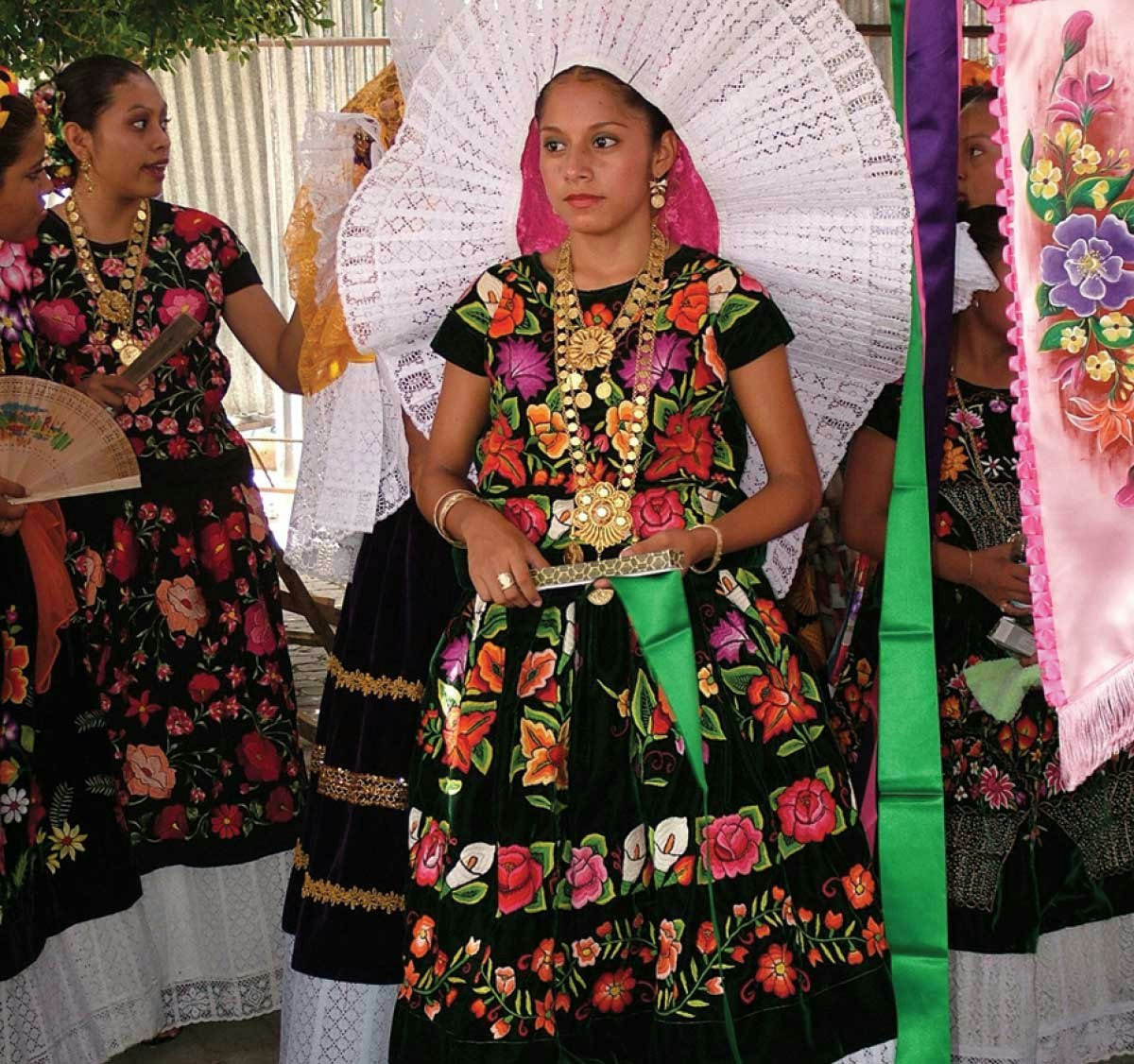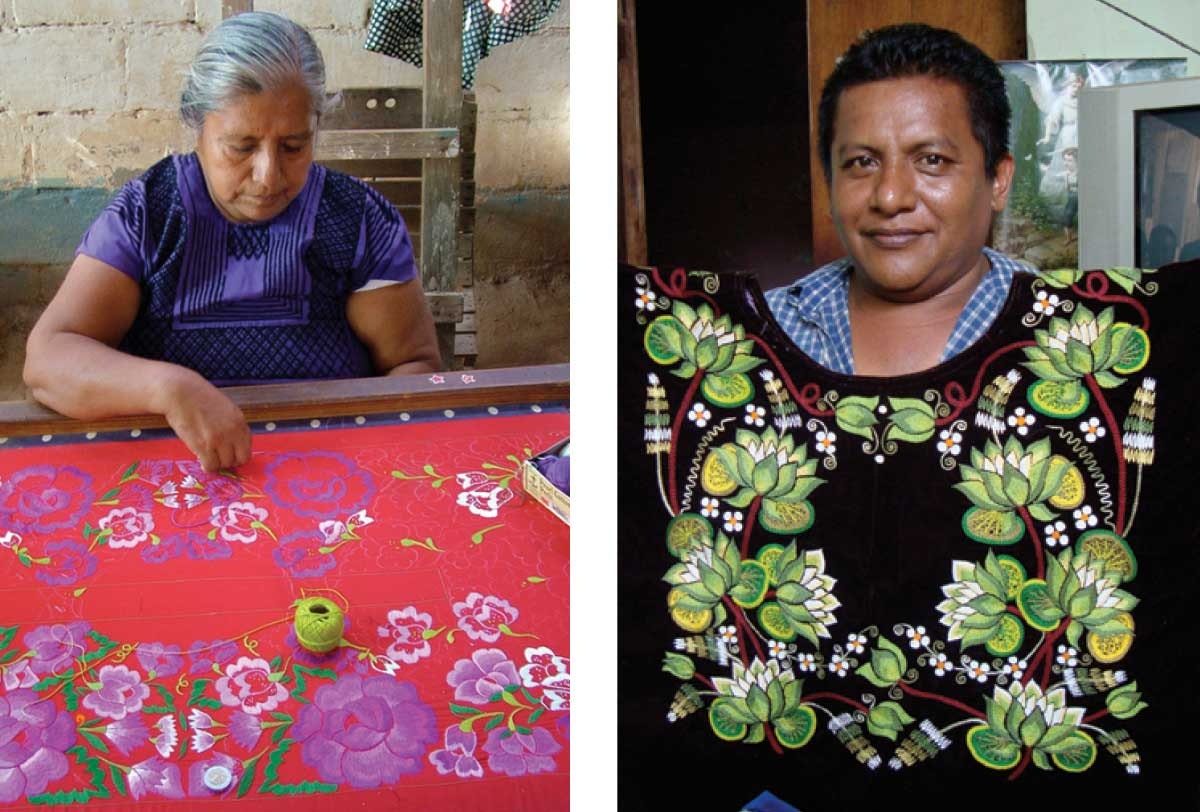Flowers abound in Mexico, but nowhere are they as glorious as the brilliant blossoms embroidered on the festival outfits of women living in Oaxaca State in the Isthmus of Tehuantepec. Residents of the area centered in the towns of Tehuantepec and Juchitán revel in their frequent celebrations called velas, which follow the Catholic calendar, honoring patron saints, uniting the community, and conserving tradition.
Each barrio (neighborhood) in a town has its own patron saint, whose annual celebration requires months of preparation, lasts several days, involves everyone in town, and costs the sponsors a great deal of money. It’s an occasion for the women, called Tehuanas (or ’Tecas if they are from Juchitán) to show off their traditional festival ensembles, comprising square-cut blouses called huipiles and long gathered skirts, each embellished with elaborate patterns embroidered in coordinating colors.
Textile historian Annegret Hesterberg notes that “Zapotec society places great importance on the prestige derived from gala attire—for the textiles used, the maker’s renown and how often one is seen sporting a new outfit. It should come as no surprise that despite globalization and the hustle and bustle of contemporary society (to which the Isthmus region is not immune), dress still exercises the same power, given that Tehuana costume acts as a form of self-representation to a degree that modern attire can never achieve.”
 Girl showing her pretty huipil grande (ruffled head covering) on the Dia de los Estandartes, when various girls’ associations parade together. Barrio Santa Maria, Tehuantepec, Oaxaca, Mexico. 2006. Photographs by the author unless otherwise noted
Girl showing her pretty huipil grande (ruffled head covering) on the Dia de los Estandartes, when various girls’ associations parade together. Barrio Santa Maria, Tehuantepec, Oaxaca, Mexico. 2006. Photographs by the author unless otherwise noted
In Tehuantepec, the mid-August weeklong Assumption celebration, La Asunción de la Virgen María, honors the Virgin Mary. Events include Mass in the blue-and-white church; a long parade of gentle oxen pulling carts filled with teenage boys; and children’s events in which little girls with bright ribbons and flowers braided into their shiny hair dress up in huipiles and skirts, and shy little boys, cajoled by eager parents, attempt dance steps beside the girls.
In the parade of the estandartes (flags), pretty girls carrying elaborate satin banners wear embroidered outfits topped by the white ruffled head covering called the huipil grande. This garment has the form of a lace blouse with sleeves, a peplum, and a ruffle around the neck, but the narrow sleeves are not used, and the garment is never worn as a blouse. Reserved for special occasions, the huipil grande is worn differently for each event. For important religious occasions, the neck ruffle is arranged to frame the wearer’s face like the white petals around the center of a marguerite daisy; for Assumption festivities, the girls wear the huipiles grandes tossed back dramatically over their head and shoulders.
In the evening, to the band’s highly amplified music, dancing begins. Women wear enaguas de holán (Holland petticoats), skirts edged with bands of stiff white lace about 18 inches (46 cm) wide. (Originally, the lace trim came from Holland, hence the name.) Their earrings, bracelets, and long gold necklaces sparkle as they move in a slow waltz. The simplicity of the men’s traditional fiesta clothing—black pants with a pure white guayabera shirt and a red bandana—makes a nice contrast to the kaleidoscopic colors of the women’s costumes.
Changes over time
The huipil has varied slightly over time, being wider and looser during certain periods and shorter and tighter in others, but always made from a rectangle folded in half with the neck cut out and the sides stitched together to the armholes. In earlier times, women wore striped cotton wraparound skirts made from fabric that they had woven themselves. Long, Spanish-style gathered skirts first appeared in the late nineteenth century. A 1929 photograph of the Tehuantepec market by the Italian photographer Tina Modotti shows half the women wearing full gathered skirts and the other half wearing straight wrapped skirts. Gradually, the straight skirts fell out of favor until only older women were wearing them; today, they are seen only among village women living near the coast.
The painter Diego Rivera, who visited the area in the early 1920s, painted the Tehuanas amid peaceful, tropical landscapes in murals that he did for the Ministry of Public Education building in Mexico City. In the 1930s, his wife, the painter Frida Kahlo, adopted Isthmeña dress and hair styles. In one photograph, taken by American photographer Nickolas Muray in 1939, she wears a huipil of red and yellow chain-stitched patterning on dark dotted fabric.
Over the years, huipiles have retained identical patterns on the front and back, making them reversible. A rectangular or square in the upper center of the blouse is always left unadorned, perhaps to set off the wearer’s gold necklace and pendant.
Techniques
The techniques used to embellish the gala costumes include hand embroidery, machine chain stitch, machine embroidery in hand-guided satin stitch, chain stitch worked with a crochet hook, and ribbon work. An embroiderer may use two techniques on the same garment. Some artists specialize in one technique or the other; some employ assistants to help them accomplish their intricate designs. Rarely, flowers are painted on cloth or made from latch-hook pile work. Hand embroidery is done with small balls of pearl cotton, available in Mexico in hundreds of colors. It’s not unusual for a flower to have eight or nine shades of thread in each petal. The inspiration for the brilliant floral designs on huipiles and skirts is believed to have come from designs on nineteenth-century mantones de Manila (“Manila shawls”), silk shawls actually made in China but imported into Latin America through the then-Spanish port in the Philippines.
Some embroiderers like to make similar flowery patterns in a signature style, year after year; others may prefer to reinterpret an old design in new colors, while still others create new botanical varieties and combinations annually. Orchids and calla lilies are popular now, as well as mixed garden flowers. Tomás Ramos Vasquez embroiders water-lily flowers with a very fine crochet hook, using one hand above the taut velveteen and the other underneath to manipulate the thread. Each time he pierces the cloth, he hooks a loop up from below, making a neat chain-stitched design.
 Left: Embroiderer working satin stitches; the fabric is stretched taut on a bastidor (embroidery frame). Tehuantepec, Oaxaca, Mexico. 2007. Right: Tomás Ramos Vasquez, master embroiderer, with the beautiful hand-chain-stitched water-lily huipil (square-cut blouse) that the author bought from him. San Blas, Tehuantepec, Oaxaca, Mexico. 2010
Left: Embroiderer working satin stitches; the fabric is stretched taut on a bastidor (embroidery frame). Tehuantepec, Oaxaca, Mexico. 2007. Right: Tomás Ramos Vasquez, master embroiderer, with the beautiful hand-chain-stitched water-lily huipil (square-cut blouse) that the author bought from him. San Blas, Tehuantepec, Oaxaca, Mexico. 2010
Tomás was twelve years old when he began to learn embroidery from his aunt. Now at thirty-eight, he’s one of the area’s most popular and proficient artists, completing thirty huipiles by himself every year. A complex design such as the water lilies takes two full weeks of eight-hour days. In his studio, assistants help stitch some of his designs under his direction, sitting and leaning over the bastidor (a wooden frame on legs), working on different sections. Tomás notes that four people working together can embroider five or six huipiles a month. Because every Tehuana who can afford it must have a new outfit for her barrio’s next fiesta, Tomás and his colleagues are unlikely to run out of work! And the tradition continues.
Techniques for Huipiles
Machine Embroidery
Chain Stitch: Some artists use a Singer 24 chain-stitch machine to embroider geometric patterns onto the cloth in a technique called cadenilla (little chain). When the machines came to the Isthmus is unknown, but photographs show the existence of chain-stitched huipiles there as early as 1910. The machine stitches with a single thread, that is, without a bobbin, and the embroiderer works from the back of the cloth. Dozens of rows of parallel stitching, overlapping at different angles, form nearly solid patterns around neck and side bands on this type of huipil.
Satin Stitch: Experienced embroiderers manipulate modern sewing machines by hand to work close zigzag stitches into smooth and graceful floral designs.
Hand Embroidery
After sewing waste cloth to all four edges of the fabric, an embroiderer clamps the long edges between the horizontal side slats of a wooden frame on legs and laces each short end around a dowel held tight by the frame. The frame prevents distortion of the fabric and allows the artist (or more than one at a time) to manipulate a needle or hook rapidly with one hand above the work and the other below. The fabrics to be decorated—satin, peau de soie, velvet, or velveteen—always are backed with printed or polka-dotted cotton cloth to give body to the ground fabric. The artist draws the design onto the cloth with a waxy white crayon or with a darker pen if the cloth is light in color.
Embroiderers use a modified satin stitch. Instead of wasting thread on the back in a standard satin stitch, they reinsert the needle very close to the place where the needle last exited. The result looks just like ordinary satin stitch from the front; only by looking at the back of the work can you detect the tiny blips of stitches that mark this technique.
Inspired by the beautiful embroideries of Mexico? Try your hand at the companion project to the article available in the March/April 2011 issue of PieceWork.
Also, remember that if you are an active subscriber to PieceWork magazine, you have unlimited access to previous issues, including March/April 2011. See our help center for the step-by-step process on how to access them.
Resources
- Burrus, Christina. Frida Kahlo: Painting Her Own Reality. New York: Abrams, 2008.
- Covarrubias, Miguel. Mexico South: The Isthmus of Tehuantepec. New York: Knopf, 1946. Out of print.
- Gosling, Maureen. Blossoms of Fire. DVD. Available from [email protected].
- Andrade, Lourdes, Charles Brasseur, Miguel Covarrubias, Sergei Eisenstein, Mathieu de Fossey, Rocío Gonzáles, Annegret Hesterberg, Alberto Ruy Sánchez, Aída Sierra, and Agustín Yáñez. “La Tehuana.” Artes de Mexico. #49, 2000.
- Sayer, Chloe. Costumes of Mexico. Austin: University of Texas Press, 1985. Out of print.
Cynthia LeCount Samaké is a textile scholar with special interests in festival costume and traditional textiles. With Chloe Sayer, specialist in Mexican textile traditions, she leads festival and textile trips. For more information, visit Behind the Scenes Adventures.
Originally published April 3, 2020; updated August 5, 2022.

